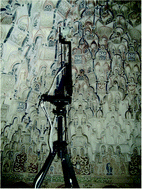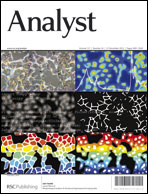A totally non-invasive in situ investigation in one of the main halls of the Palace of the Lions in the Alhambra (Granada, Spain) has been carried out. Analyses were made with a fiber-optic portable Raman microspectrometer placed on scaffolding platforms at a height of ca. 12 m above the ground level during the period of conservation works. The objects of this study are the decorated plasterworks in the seven vaults of the Hall of the Kings. Together with the results, the different practical problems related to the positioning of the instrumental setup and the influence of the local environment during the analysis are discussed. In general, high quality spectra were obtained despite difficulties for micro-probe head positioning and sometimes the vibrations of the corresponding scaffold. Different typical antiquity pigments have been identified: cinnabar, minium, carbon black and lapis lazuli. Furthermore, the luminescence pattern from lapis lazuli found in most blue decorations has allowed the establishment of the natural origin and provenance of the pigment. Apart from this natural lapis lazuli, synthetic ultramarine blue was also found in one of the vaults showing up a recent restoration. In addition, some degradation products of cinnabar and minium were identified, with the major advantage of providing real-time information to the conservators during their work.

You have access to this article
 Please wait while we load your content...
Something went wrong. Try again?
Please wait while we load your content...
Something went wrong. Try again?


 Please wait while we load your content...
Please wait while we load your content...